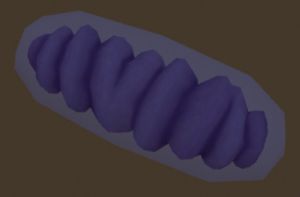Mitochondrion
The powerhouse of the cell. Mitochondria perform Aerobic Respiration, or the conversion of Glucose ![]() into ATP
into ATP ![]() with the use of Oxygen
with the use of Oxygen ![]() . Mitochondria perform this function more efficiently than other organelles such as Metabolosomes.
. Mitochondria perform this function more efficiently than other organelles such as Metabolosomes.
Requirements
A cell must have a Nucleus to evolve Mitochondria.
If organelle upgrades are enabled in game settings, both of the following conditions must also be true for the player cell:
- Contains at least 4 Metabolosomes for at least 5 generations in a row.
- Produces at least +20 ATP
 .
.
Processes
Aerobic Respiration: Glucose ![]() + Oxygen
+ Oxygen ![]() → ATP
→ ATP ![]() + Carbon Dioxide
+ Carbon Dioxide ![]()
One of the main methods of energy production, superior to that in Metabolosomes. Requires a steady influx of Glucose ![]() . Rate scales with the concentration of environmental Oxygen
. Rate scales with the concentration of environmental Oxygen ![]() .
.
Modifications
No modifications.
Effects
No effects.
Upgrades
No upgrades.
Strategy
In environments with plentiful Glucose ![]() , Mitochondria are indeed the powerhouses of the cell. Be aware though that Glucose
, Mitochondria are indeed the powerhouses of the cell. Be aware though that Glucose ![]() concentrations decrease as the game progresses, so we recommend switching to alternative energy sources if possible.
concentrations decrease as the game progresses, so we recommend switching to alternative energy sources if possible.
We also recommend replacing Metabolosomes with Mitochondria after evolving a Nucleus for far greater efficiency.
Scientific Background
Mitochondria are bilayered (having both an inner and outer membrane) organelle that generate ATP through a process called Oxidative Phosphorylation. In this process, energy generated from the breakdown of nutrients (such as glucose and lipids) is used to generate a proton gradient across its inner membrane, which it can then use to phosphorylate ADP into ATP.
While in the game, mitochondria are depicted as big rod-shaped organelles, their shape and size is actually very flexible. Mitochondria are constantly fusing together and splitting apart depending on the demands of the cell. They can even form large networks with other mitochondria within the cell. These dynamics are important for (among other things) regulating metabolism and mitochondrial quality control, as mitochondrial shape greatly affects their function.
One notable aspect of the mitochondria that separates it from most organelles is that it contains its own DNA. Because mitochondria were originally an independent organism that was acquired by a host cell, they contain DNA plasmids within their matrix (inside their inner membrane). Over time, the mitochondria became more and more dependent on the host cell and lost its ability to live independently.
While the mitochondria is best known for being the powerhouse of the cell, it actually does so much more than provide energy. It is an integral part of programmed cell death, cell signalling, and the synthesis of various molecules such as phospholipids. Currently, there is research trying to understand these processes, as well as trying to uncover new roles that the mitochondria plays.
